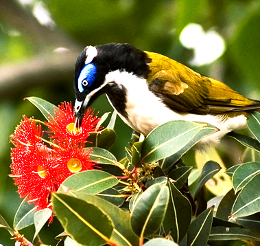Science spies flowers' speech through the eyes of a bird
 New research has revealed the evolutionary links between some Australian birds and the flowers they pollinate, showing some plants change their colour to suit birds’ taste, and may even try to communicate directly to them.
New research has revealed the evolutionary links between some Australian birds and the flowers they pollinate, showing some plants change their colour to suit birds’ taste, and may even try to communicate directly to them.
A recent study used mathematical models of bird vision to represent the colours of Australian flowers, in the same way that the birds themselves perceive colours.
A team of biologists from Monash and RMIT universities in Melbourne used statistical techniques to show that a small range of colours evolved among bird-pollinated flowers far more often than would occur by chance.
The study measured the wavelengths of light reflected from the petals of 234 native Australian species of flowers, consisting of 80 bird-pollinated species and 154 insect-pollinated species.
The researchers translated the spectral reflectance patterns of flowers into single points in a ‘colour space’, representing the sensitivities of the four kinds of colour receptors in bird vision.
According to the research, about half the flowers that were bird-pollinated overlapped with the colour space occupied by insect-pollinated flowers.
“The other half of bird-pollinated species, however, were crowded in a narrow and separate stretch that occupied just one per cent of the total volume of the colour space,” said Professor Martin Burd, from Monash University.
“These colours appear red to humans, and we named this cluster the ‘red arm’. Their reflectance profiles would also strongly stimulate the red receptors in bird eyes.”
Professor Burd says the study indicated many flowering species have evolved to ‘talk’ to birds using a very particular set of colour ‘words’.
“In particular, the distinctiveness of the ‘red arm’ appeared only when the colour space was based on the visual system of honeyeaters,” he said.
“Models of the other visual system in birds with ultraviolet receptors, common in parrots and songbirds, did not reveal a distinctive red arm of floral colours.”
Professor Burd said it was not surprising given honeyeaters are the main bird pollinators in Australia.
The research team concluded that there has been significant evolutionary convergence in the colour of bird-pollinated flowers in Australia, and that there visual system of honeyeaters has been the driver of this convergence.
“The birds are talking honeyeater language because that’s where all the action is,” Dr Burd said.
Dr Burd says he believes in contrast, Asian and African flowers visited by songbirds which use ultraviolet-sensitive receptors, should not have significant convergence on the red arm.
“Is this the case? It’s a question we hope to answer next,” he said.








 Print
Print